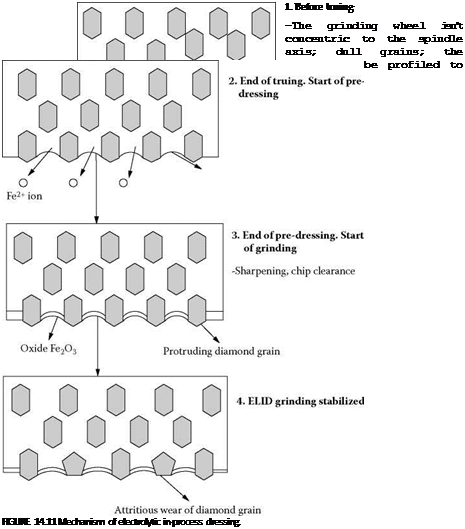ELID grinding technique was used for the first time in Japan at the Riken Laboratories. The pioneers of this technique are Dr. Hitoshi Ohmori and Prof. Takeo Nakagawa. Dr. Ohmori’s new method is a result of the development over several years of the combined grinding and dressing technique for hard and brittle materials in an effort to effectively utilize cast-iron fiber-bonded wheels that are considered to be the toughest among all metal-bonded wheels. Nakagawa found one solution for the efficient machining of the ceramics is to use a cast iron-bonded diamond grinding wheel mounted on a rigid numerically controlled grinding machine. A cast iron-bonded wheel is a metal-bonded wheel of very high strength. It gives a low wear rate, and a high grinding ratio even at a low grinding speed [Green and Hannink 1989, Ohmori and Itoh 1998, Ohmori and Li 2000b]. Ohmori and Li [2000a], at the Institute of Physical and Chemical Research (RIKEN), successfully applied the ELID to grind hard materials components and studied the possibility to apply this new technique for surface grinding, centerless grinding, and double-sided grinding. Efficient and precise ELID grinding was successfully carried out on Si3N4 and ZrO2, titanium carbide, and sialon. Mirror surfaces were achieved using the ELID technique, the best surface roughness and precision being obtained with a #4000 diamond wheel using through-feed grinding. Marinescu and Ohmori [1999], from the Abrasive MicroMachining Laboratory, Toledo, performed ELID centerless grinding on different types of ceramics at RIKEN Laboratories in collaboration with the ELID Grinding Project Team from Tokyo. The following conclusions were obtained:
• Stable, efficient, and precision grinding for ceramic components has been achieved by mirror grinding with ELID technique.
• Efficient and precision truing by the electrodischarge method for metal-bonded grinding wheels for centerless grinding can be achieved.
• Good ground surface roughness and accuracy are offered with #4000 metal-bonded grinding wheel by through-feed grinding for ZrO2 optical fiber ferrules [Marinescu and Ohmori 1999].
Lee [2000], at Pusan National University, Korea, proposed a dressing system controlled by computer for ultra precision grinding of STD-11, die steel. The superabrasive wheel is CBN 12000.
 |
Bandyopadhyay [1996] performed ELID grinding experiments for Oak Ridge National Laboratory at Riken Laboratories under the supervision of Dr. H. Ohmori during two summers at Riken. Part I of his research addressesd basic aspects of ELID grinding affecting the rate of material removal, the normal forces developed during grinding, and the conditions that improve the ratio of the material removed to that of abrasive consumed. Part II of the report addressed the effects of ELID grinding on the bending strength of silicon nitride.
Hong and Li [2000] studied theoretical aspects of ELID at the University of Rochester, New York. They studied the anodic metal matrix removal rate in ELID. The electric field or current density distribution around a diamond particle embedded in a metal anode during ELID was
calculated for the two-dimensional case of a long diamond particle, without a particle and with some protrusion. The mathematical model and the assumptions are presented in two recent articles
in the Journal of Applied Physics.
14.5.3 Summary on ELID Grinding
ELID grinding is a new technique and has given good results for machining hard silicon nitride and zirconia. This grinding technique is highly recommended for machining ceramics. However, up to this time, no published research could be found related to ELID grinding of ZTA ceramics.
The possibility of implementing this method in different types of grinding processes and for different concentrations of diamond in the grinding wheel has been demonstrated experimentally. Some characteristics related to surface finish are available. However, the influence of the grinding regime (rotational speed, depth of cut, and feed) on the surface roughness has been insufficiently explored.
A mathematical model of the anodic metal matrix removal rate in ELID has been developed. This theoretical approach, however, has not yet been applied to the modeling of the predressing time.
